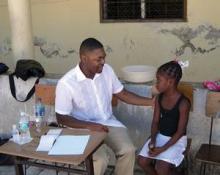In the weeks following the massive earthquake in Haiti on Jan. 12, Dr. Alix Charles, a first-generation American of Haitian descent, worried that international concern for the country’s long-term medical and economic needs would wane as the aftershocks abated.
Relieved to know that his immediate relatives back in Haiti all had survived the devastating quake, Dr. Charles shifted his focus to the rebuilding of Haiti, which includes its medical programs.“Pretty soon people’s minds are going to shift, but I do hope that they will continue to think about Haiti and continue to make contributions; not just monetary, but whatever contributions they can,” said Dr. Charles, who practices dermatology in Hinsdale, Ill.
Over the past 6 years, Dr. Charles has made several trips to Haiti on volunteer medical missions with the American Academy of Dermatology through its Education and Volunteers Abroad Committee. Led by academy members Dr. James J. Nordlund and Dr. James O. Ertle, also a dermatologist in Hinsdale, Dr. Charles would travel with the committee to Leogane (about 20 miles west of Port-au-Prince) to provide dermatologic education to local medical practitioners.
“The whole goal in going down there and we’ve been going down since 2001 is to set up teaching programs,” said Dr. Nordlund, who practices dermatology in Cincinnati. Most dermatologic care in Haiti is provided by family practitioners who have no background or training in the specialty, said Dr. Nordlund. “So they really don’t know how to make the diagnosis. And they guess, and sometimes they get it right, but sometimes they don’t.”
The physicians, through their semiannual trips to Leogane, teach local health care professionals – from residents to nursing students – how to diagnose and treat the 15 most common skin conditions found in developing countries, including fungal infections, eczema, scabies, herpes, cold sores, and shingles. By concentrating on the most prevalent conditions, they are helping the local providers to treat about 80% of the skin problems presented by patients in Haiti, Dr. Nordlund said.
Dr. Nordlund, Dr. Charles, and other members of the committee also helped to establish a dermatologic pharmacy at Cardinal Leger Hospital in Leogane, a small facility run by fewer than a dozen nuns. Unfortunately, the devastation caused by the recent earthquake left most of the facilities in ruins.
“The hospital and the home where the sisters lived – that’s all destroyed ... just demolished, flat on the ground,” said Dr. Nordlund. But the clinic in which they had the pharmacy and the facilities to take care of patients is still intact.
Even with the news that some of the clinics where they had worked were spared in the earthquake, Dr. Charles said he still felt uneasy. “I was terribly worried for the people I knew on the ground,” he said. “I knew this was only going to amplify their need for medical care, and obviously emergency assistance,” said Dr. Charles.
But, with his 2010 mission to Haiti postponed, Dr. Charles said he hopes the exchange of medical information and expertise will not be lost in the urgency to provide emergency care to the stricken region.
“I try to encourage people, if they go down and administer care, to try to also teach a little bit, so that the knowledge and skills don’t leave the island with them.”
Dr. Nordlund says he is planning to return in the fall to launch a dermatology lecture series at the Université d’Etat d’Haiti in Port-au-Prince – the first program of its kind to be taught at the medical school.
But the American Medical Association warns physicians interested volunteering in Haiti to keep in mind the desperate conditions. “Physicians must be prepared to provide care in a physically challenging, austere, resource-constrained environment,” reads a statement on their Web site. The association encourages all physicians considering taking part in the relief effort to read the Disaster Medicine and Public Health Preparedness journal, which can be accessed online at www.dmphp.org.
For now, Dr. Charles rests stateside with thoughts of Haiti in his heart and mind.
“There’s a lot that Haiti’s going to need to rebuild, and the same goes for medical care, and in particular medical education.”
Photo courtesy Dr. Alix Charles


